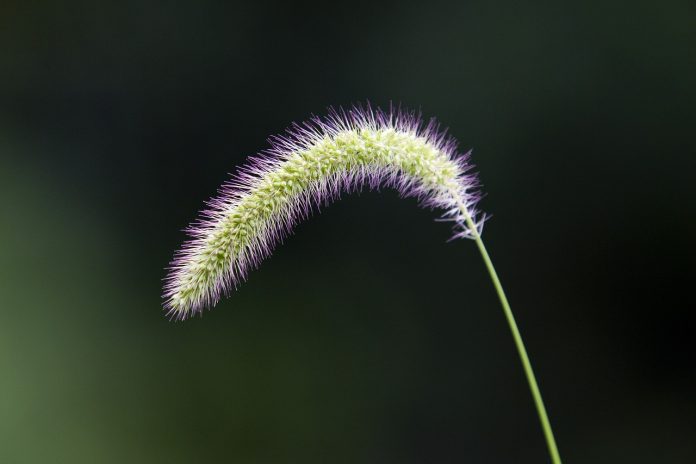Cool nights and pleasant warm days leave me thinking I can accomplish just about anything. I may get so overconfident I think I can eliminate foxtail.
There are a handful of weeds out there that are regular offenders in hay and pastures and foxtail is one of them. In the world of extension topics, I can count on foxtail questions every fall and through winter into spring as animals begin to reject hay.
Know your enemy
It comes in three forms: giant, green and yellow. Foxtails readily grow and are opportunistic colonizers of bare spaces. They will creep into your pastures, your hayfields, soybean fields, lawns and field edges where there is an opportunity.
They are summer annuals and thrive by the “live fast and die-hard” model which means they produce a lot of seed, spread rapidly, die in the fall and return next year.
The foxtails are infamous for seeds that get caught in the gums of livestock which leads to animals rejecting feed and possibly getting infections in the mouth.
As a grass, it is easily overlooked before it enters the reproductive phase and sets a seed head. The vegetation itself is fine, but it is the seed head that causes all the trouble.
In the case of giant foxtail, I learned to easily recognize it as the plant I could walk out into a field and shake hands with. That sets it apart from most other grasses in shape and form.
The seed head is large, soft and droops over in greeting. The green and yellow foxtail take a few more minutes to distinguish from each other, but usually, stand out from other grasses when they produce their seed head with a bottlebrush-like form.
Know your options
If foxtail is truly a problem in your pasture, you have essentially two choices: renovation or complete burn-down.
I find many cases where the land manager is reluctant to make changes to what they are currently doing, but in the case of foxtail, change is required or you will continue on the exact same path you find yourself in.
Renovation might involve soil testing and fertility adjustments, adjusting mowing timing and go as far as plowing sections under.
Regular mowing will not eliminate foxtail and there may be considerable seed bank in the soil. However, if you can time mowing so to hit giant foxtail between boot stage (seeds start developing in the sheath) and seed set you can suppress the spread of most seed.
Even if you spray with an herbicide in a complete burndown, you still should expect that considerable seed bank may be in the soil and adjust management to suppress foxtail for a few years.
A good stand establishment will go a long way in out-competing new foxtail seedlings. With green and yellow foxtail, in particular, I’ve noticed that seeds heads can still appear under very low mowing heights and continue to be a problem. So it is a good strategy to try to allow the grasses to grow tall before cutting to make management by mowing more successful.
Know your fields
Managing foxtail is really part of a broader strategy of managing a pasture or hayfield. It’s important to take stock of the plant species in your fields and make adjustments accordingly. Foxtail is probably a game-changer for most managers if it gets established because it will be hard to sell and use your hay.
This year, during Farm Science Review in London, Ohio, we had grazing demo plots at the Gwynne Conservation Area. As with many parts of Ohio, planting was delayed by persistent heavy rain and in this location, the day the plots were planted in June was the day the rain completely stopped and planting suffered.
The result in most of the demo plots is mostly foxtail. In September, I walked out into the plots and the drill furrows from planting were large cracks I could still stick my fingers into.
There were a few things to discuss with passersby and a lovely stand of foxtail with which to figure out how to have a useful discussion about forages.














could you give me some advice on battling green foxtail? we live in high winter country, and it came in hay about 2 years ago which they hay people normally baled the patch of foxtail and then burned the bales, but inadvertently sold us several bales, which we fed out (as in the winter we feed in the dark, and their hay had always been so good, i never noticed till the day later when I checked my gloves and saw the seeds stuck in my gloves); the horses had already eaten the hay; and I found another bale which at least we didn’t feed…now there are several very large patches of foxtail, I’ve sprayed w/roundup, dug up what I could and I noticed another area quite a ways away which must have had the same thing happen, and it is rapidly spreading…driving me crazy; too hilly to mow, and i’ve tried pulling the seedheads, but they just keep coming on; we did some helicopter seeding for forage and are getting some good grasses, orchard grass, timothy and other native grasses, but I can’t see them out competing this horrible grass…we had a ton of rain this year and grass i up to my shoulders, but the foxtail is taller and spreading more…I plan to go get several jugs of round up and spray the crap out of it and continue every two weeks following…any suggesntion would be helpful, i’m at a wits end.